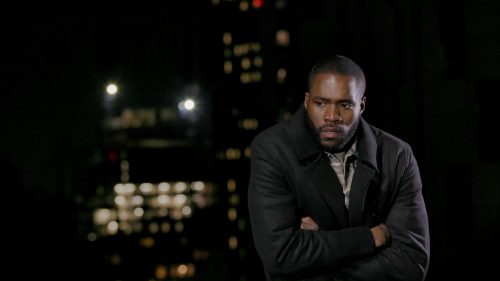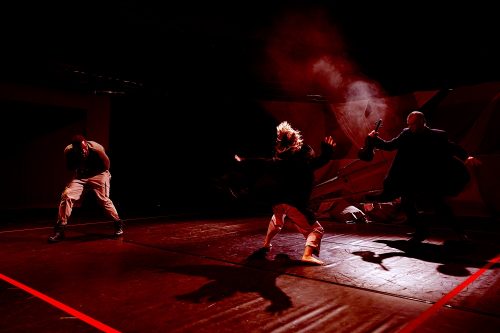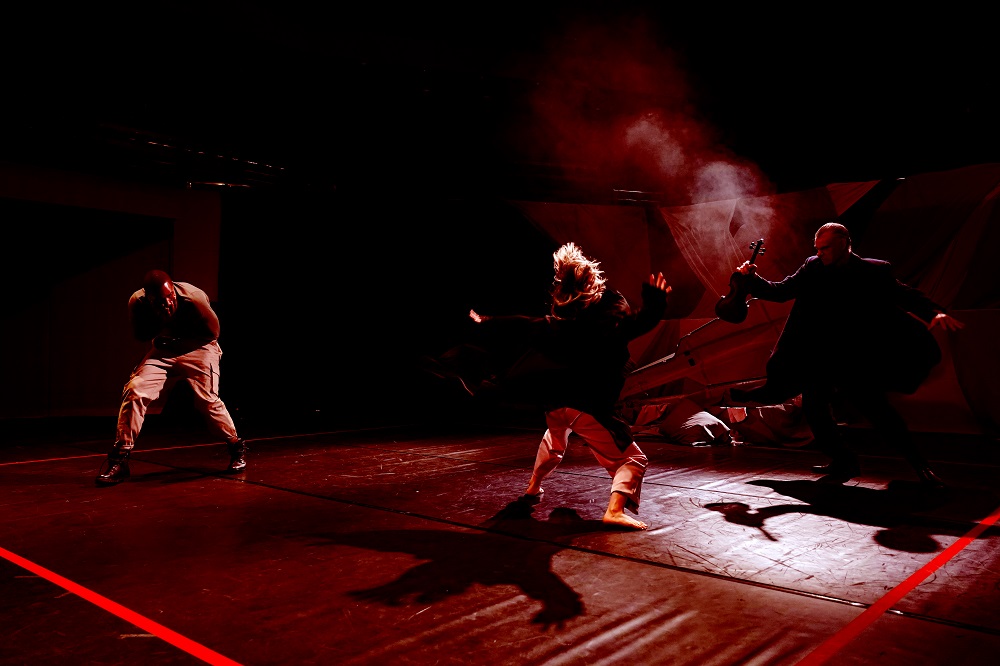 United Kingdom Stravinsky, The Soldier’s Tale: Hallé / Sir Mark Elder (conductor). Filmed in various locations in Manchester (by Maestro Broadcasting) and first streamed on 29.4.2021. (JPr)
United Kingdom Stravinsky, The Soldier’s Tale: Hallé / Sir Mark Elder (conductor). Filmed in various locations in Manchester (by Maestro Broadcasting) and first streamed on 29.4.2021. (JPr)

Musicians:
Peter Liang – Leader/Violin
Billy Cole – Double bass
Sergio Castelló López – Clarinet
Emily Hultmark – Bassoon
Gareth Small – Trumpet
Katy Jones – Trombone
David Hext – Percussion
Production:
Annabel Arden and Femi Elufowoju Jr – Co-Directors
Dominic Best – Film Director
George Johnson-Leigh – Designer
Jeremy Sams – Translation
Cast:
Richard Katz – Narrator
Martins Imhangbe – Soldier
Mark Lockyer – Devil
Faith Prendergast – Princess
A fascinating end to the Hallé’s 2020/21 Winter Season as Sir Mark Elder conducted members the orchestra in a new filmed version of Stravinsky’s 1918 masterpiece The Soldier’s Tale (L’histoire du Soldat) for the 50th anniversary of the composer’s death. Stravinsky and Swiss writer Charles Ferdinand Ramuz conceived it to ‘be read, played, and danced’ (lue, jouée et dansée) by three actors, one or more dancers and seven instrumentalists. This small ensemble was necessitated by a pandemic of a century ago caused by Spanish flu. It became one of the first examples of a genre we now recognise as music theatre. It is based on a Russian fairy tale and explores the familiar Faustian myth and becomes the parable of a soldier who returns from war and exchanges his treasured violin for a book in which he will find the secrets of untold economic wealth. The buyer is the devil and he had bought the soldier’s soul.
Stravinsky’s changing time signatures (which means a conductor is often essential), harmonies and melodies are distinctly of the twentieth century. The music is lively, alternately rhythmic and lyrical and ‘samples’ a number of influences. Alongside Luther’s ‘Ein feste Burg’ in ‘Petit choral’ (‘Little Chorale’), there is klezmer music and Bach, as well as jazz and popular dances such as the pasodoble in ‘Marche royale’ (‘The Royal March’) and ‘Tango – Valse – Ragtime’ (played by the soldier to heal the princess). They conjure up a world recovering from the First World War and although it is not particularly about that war, it will now be thanks to co-directors Annabel Arden and Femi Elufowoju Jr for the Hallé.
We read how this Soldier’s Tale is ‘Celebrating Lt James Reese Europe, born 1881, Alabama, died 1919, New York. Soldier, bandleader and activist, he fought and made music with his regiment 369th Infantry, the Harlem Hellfighters, in WWI. His coffin was carried through the streets – the first ever public funeral for a Black American in New York City’. Sadly, Europe died from a knife wound inflicted on him during a dispute with one of his drummers during a concert. Years later Europe was called the ‘Martin Luther King of music’.
The narration begins ‘Here’s a soldier with his pack, trudging down a dusty track’ though the figure in his army fatigues is walking more briskly than just ‘trudging’ and the ‘dusty track’ is beside the Rochdale Canal in Manchester city centre. This already hints at the rhyming nature of Sams’s oft-used modern and witty translation. It continues ‘Ten days leave that’s all he’s got which is not an awful lot’. We now follow a narrator, the soldier and the devil through a myriad of locations (outdoor and indoor) in the city which is blended with footage from a performing area in the Bridgewater Hall (I assume) where the musicians become involved in what we see.
The devil spies on the soldier and while he is rummaging through his kit bag looking for the portrait of his girlfriend Yvonne, he takes out his battered violin. The devil persuades the soldier to swop it for ‘a book that foretells the future’ and to stay with him for just three days to be taught about the book in return for violin lessons. The opportunity film provides in bringing The Soldier’s Tale to life can be see when the two characters give the illusion they are riding like the wind in ‘a tall black carriage with six black horses’ and you will believe they can fly! The soldier is back at the canalside and ‘Marching home, he goes marching home’.
(Spoiler alert!) when he gets there things are not right, the girl he left behind is married with children and he is shunned ‘To them I’m a ghost, I’m a zombie, I’m dead’. (As a for instance on how Stravinsky’s music often acts as a Greek chorus to the unfolding story there is a plaintive interlude [‘Pastorale’] with the bassoon and clarinet duetting.) The soldier (seen atop a Manchester city centre car park) soon appreciates – as many of us do – that money doesn’t always bring happiness, ‘You see those who have nothing have everything and I who have everything have nothing, nothing at all’ and he concludes ‘I walk among the living and I am dead.’ The devil is in disguise (wearing a dress!) and tempts the soldier with ‘Pretty, pretty things’, offering his original possessions back to him including the violin which the solider cannot get a sound out of. He will hurl it away and tear up the book as Part I ends.
We continue the tale of ‘our reluctant millionaire’ in Part II and he soon arrives at a village inn (here the city’s famous Peveril of the Peak pub). The soldier learns the king’s daughter is ill and isn’t eating or sleeping and whosoever cures her can claim the royal princess as his wife. ‘I’m going to see the king’, cue some jazzy, syncopated music from musicians with paper crowns on their heads (and looking slight embarrassed). The devil now assumes the character of a drunken violinist and in this encounter – in the undercroft of Bridgewater Hall – the soldier challenges him to a game of cards. The more of the devil’s money he loses the stronger the soldier becomes and the weaker he is. Playing the violin once again we heard ‘Petit concert’ (‘The Little Concert’) which was music that cried out to be choreographed (but wasn’t). The princess has been sleeping in pink pyjamas (in a double bass!) and she is restored to health as the soldier plays the ‘Three Dances’. It is as if – as a Petrushka-like marionette – the violin is pulling the princess’s strings. Eventually she spins round and round and in the blink of an edit she is in a black sparkly flapper-style dress with a boa, a champagne glass in hand and dancing with the soldier.

(c) Hallé
There is some mock bullfighting, but it is the violin’s ‘Devil’s Dance’ music that tames the devil though he promises to have his revenge exclaiming ‘You have to choose, you can’t have everything that’s not allowed’ and the soldier must choose. He has been told not to leave the castle but returns home because now he has a wife, he needs his mother too (‘Maybe this time she will know me’). He soon loses the princess and is back by the canal and under the devil’s influence. The final piece is a ‘Marche triomphale’ for violin and percussion though it sounded to me more like a ‘Danse Macabre’. As the soldier dies he poignantly drops a faded photo of Lt Europe and it is the devil on the conductor’s podium who has the last laugh.
All credit to Sir Mark Elder who conducted with a light touch and consummate feel for Stravinsky’s neo-classical music. The spare – though rhythmically complex – score gave none of his Hallé musicians anywhere to hide though each gets its own voice. Each of the septet was as virtuosic as the other, though as leader and violin soloist James Liang caught the ear with his characterful violin playing, particularly in Stravinsky’s sequence of dances.
Catching the eye was Martins Imhangbe as the engaging and charismatic soldier who co-directors Arden and Elufowoju Jr clearly want those watching to root for. Since this was my first The Soldier’s Tale, I was hoping the soldier would have a happy ending, but it was not to be of course. Imhangbe is a young talent with considerable screen presence and one to look out for in the future.
Mark Lockyer’s devil seemed designed to be someone who would not frighten children in the unlikely event any saw this film. He skilfully brought to life the different facets of his character’s devilish persona without really being sinister enough. I don’t know if Lockyer has done much pantomime, but he would make a good villain in that. In a much-reduced role as the narrator Richard Katz flitted in a chattily fashion in and out of the story.
I think the opportunity was missed for more dance, as I suspect was Stravinsky intention for his The Soldier’s Tale. Now however, because of its riveting part narration, part dialogue enhanced by some extraordinarily well played music, I was pulled into Stravinsky’s world which took a grip and wouldn’t let go of me until the end.
Jim Pritchard
For more about the Hallé click here.
